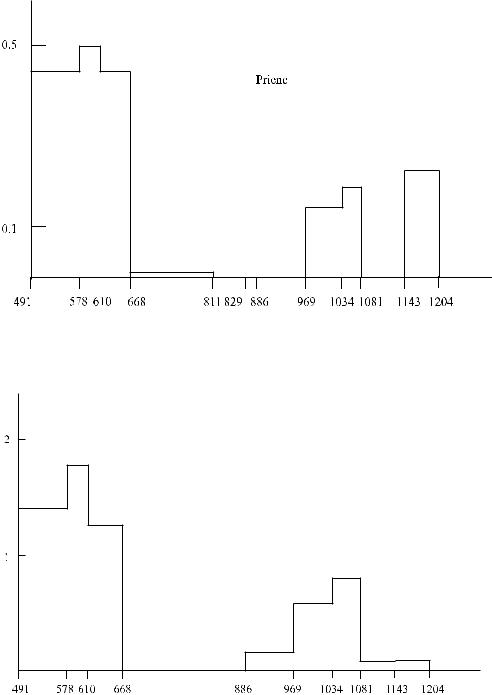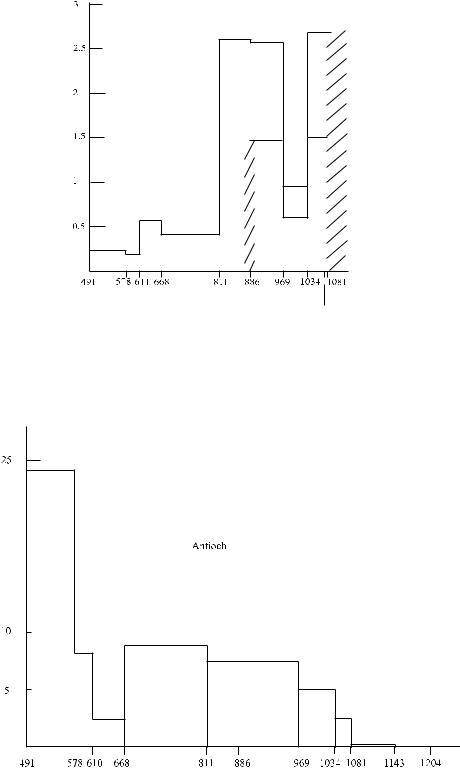
The Economic History of Byzantium From
.pdf

Albania
6.3. Monetary finds from Albania (based on data from H. Spahiu, “Monedha bizantine të shkekujve V–XIII, të zbulurara në territorin e Shqïpërisë,” Iliria 9/10 [1979–80]: 353–421)
Sardis
1910–1914
1958–1968
6.4. Monetary finds from Sardis





Turnovo˘
6.13. Monetary finds from Turnovo (based on data from K. Dochev, Moneti i parichno obreschenie v Trnovo XII–XIV [Veliko Turnovo, 1992]

Byzantine Money: Its Production and Circulation |
913 |
reigns of Justinian, Maurice, Phokas, and Herakleios, probably ceased when Cartagena fell to the Visigoths in 615.
The age of Herakleios was very troubled, resulting in new temporary military mints that struck a bronze coinage to meet the needs of the troops, in 609–610 at Cyprus and Alexandretta (Alexandria ad Issum),13 in 613–14 in Jerusalem, in 615–619 in Isauria, and again in Cyprus in 629. The folles series with immobilized or blundered mintmarks has been convincingly shown to be die-linked to organized issues from 610 to 630 under Persian rule.14 Whatever the nature of the mint authority, the existence of these more or less regular folles, and of numerous imitations, of the Herakleios type, then of that of Constans II, as well as countermarks with Herakleios’ monogram applied in Syria-Palestine during the years around 626–662, all witness to the vitality of money circulation and demand in the region. It is not impossible that these requirements were met, successively or alternatively, first by the Byzantine authorities and then, after the Arab conquest, by the cities or other administrative bodies, which continued to do so until the onset of a bilingual Arab-Byzantine coinage ca. 680 or later, followed by Abd al-Malik’s reformed coinage in 697.15
The disappearance of the sacred largesses can be dated to 610; this, together with the devolution of its previous prerogatives to the sekreta of different logothetes, brought the production of money under the authority of the vestiarion. The reference, in 899, to an a“rcwn th'" caragh'"(master of the mint) found in the kletorologion of Philotheos places him among this offikion’s staff. The precious metal was probably smelted in the crusocei'onmint, whose archon was dependent on the sekreton of the eidikon. This official can be identified with certainty with the crusoeyhth´" attested to by Philotheos and earlier, in 842–843, by the Uspenskii taktikon. Finally, the zygostates, the controller of the weight and quality of the imperial coinage, was dependent on the office of the sakellion.16
These few data apply to the capital, whose production was intended to supply the eastern themes (Asia Minor and the Balkans), which constituted the empire’s heart and principal support. Thus Constantinople alone supplied a large area with both bronze and precious metals (see Fig. 1b). This centralization was broken only very partially
13Hahn (MIB 2:86–87) rejects the attribution proposed by Philip Grierson and assigns this issue to Alexandria. In the absence of known provenances, it is impossible to decide the matter.
14H. Pottier, Le monnayage en Syrie sous l’occupation perse/Coinage in Persian Syria (610–630), with a historical introduction by C. Foss, Cahiers Ernest-Babelon 8 (Paris, forthcoming).
15C. Morrisson, “La monnaie en Syrie byzantine,” in Arche´ologie et histoire de la Syrie, vol. 2, De la pe´riode perse `a la pe´riode byzantine, ed. J.-M. Dentzer and W. Orthmann (Saarbruck, 1989), 191–204; eadem, “Le monnayage omeyyade et l’histoire administrative et ´economique de la Syrie,” in La Syrie de Byzance `a l’Islam, VIIe–VIIIe sie`cles, ed. P. Canivet and J.-P. Rey-Coquais (Damascus, 1992), 309–18 (commentary by M. Bates, 319–21). This has recently attracted growing interest, and many articles have appeared. For an updated survey, see C. Foss, Introduction to Coinage in the Near East in the Seventh Century (Washington, D.C., forthcoming).
16N. Oikonomides, Les listes de pre´se´ance byzantines des IXe et Xe sie`cles (Paris, 1972), 315–17. In the 12th century the smelting workshop was also the place where coins were struck. Does the following definition in the Souda (ed. A. Adler [Leipzig, 1935]), 4:833) refer to these dual functions? Crusoeyhtei'onÚ“nqae cwneu´ousi kai` e”yousi to`n cruso´n.

´
914 CECILE MORRISSON
Table 2
Centralization and Fragmentation of Monetary Production
(Mid-7th–11th Centuries)
Administrative |
|
Mints |
Metals |
District |
Theme |
(temporary mint) |
Minted |
East |
Thrace |
Constantinople |
AV, AR, AE |
|
Macedonia (est. 824) |
(Thessalonike?) |
AE (9th, 11th centuries) |
|
Kherson (est. ca. 832) |
Kherson |
AE (842–989?) |
West |
|
Rome |
AV, AR, AE |
|
|
Ravenna |
AV, AR, AE |
|
|
Naples |
AV (ca. 660–842) |
|
|
Syracuse |
AV, AE (642–879) |
|
|
(transferred to Reggio) |
AV, AE (879–912) |
Note: AE copper; AR silver; AV gold.
when the two provincial mints at Kherson and Thessalonike resumed activity with the creation of new themes and the reorganization of former districts under Emperor Theophilos. Kherson began issuing cast bronze coins with the imperial monogram at the end of the reign of Michael III. This series with its particularly easily recognized fabric continued until Basil II.17 Other bronzes of Michael II and Theophilos, in a fairly easily recognizable style, can very probably be attributed to Thessalonike. Other folles of Basil I and Leo VI, sharing some traits with Sicilian issues, have been convincingly attributed, on the basis of local provenances, to Reggio where the mint of Syracuse was likely transferred after 879.18 Hendy has suggested also attributing to Thessalonike the folles that bear the name of Constantine X and his successors until 1092, which would have been struck by the provincial mint while Constantinople was striking anonymous folles. However, this thesis has yet to be confirmed by research into the provenances.19
In the empire’s last western possessions, the situation contrasted diametrically with
17A. Anokhin, Monetnoe delo Khersonesa (IV v. do n.e.–XII v. n.e.) (Kiev, 1977) (The coinage of Khersonesus: 4th Century B.C.–12th Century A.D.) BAR International Series 69 (Oxford, 1980). The chronology by I. V. Sokolova, Monety i pechati vizantiiskogo Khersonesa (Leningrad, 1983), is preferable.
18Thessalonica mint, see D. M. Metcalf, “The Folles of Michael II and Theophilus before his Reform,” HBN 21 (1967): 28–29 (nos. 30–36); idem, “The Reformed Folles of Theophilus: Their Styles and Localisation,” ANSMN 14 (1968): 132 (groups S and Z). Cf. Hendy, Studies, 423–25, with the earlier bibliography. See V. Penna, “Numismatic Circulation in Corinth from 976 to 1204,” EHB 655–58. Reggio mint, see D. Castrizio, “La zecca bizantina di Reggio dopo la conquista araba di Siracusa,”
Akten des XII. Internationaler Numismatischer Kongreß (Berlin, 2000).
19Hendy, Studies, 428. He now attributes these folles to the moneta publica in Constantinople (DOC 4.1: 22–28).

 AE index only
AE index only